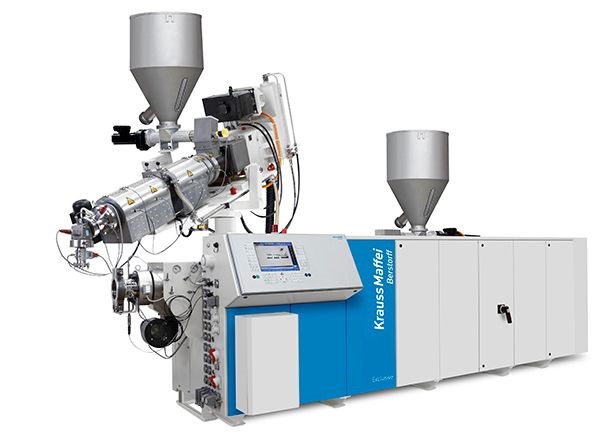


Image courtesy of KraussMaffei Group shows a profile extruder and co-extruder used to produce plastic profiles made up of two material types.
Extrusion is a continuous process in that it is not cyclical in nature. Unlike injection moulding, material is continuously pumped through the plasticising unit. The screws rotate continuously at a set speed (RPM) feeding material into a die (tool). The profile is continuously pulled through the die to produce the desired geometry of the component.
The design of the die, screw size and downstream equipment dictate the type of product that can be produced on the extruder.
Visit here to contact the leading UK companies that can provide you with advice and quotes for your extrusion machine requirements.
The molten material is pushed through a die (tool) as it exits the extruder. A profile is created as the material passes through the die and starts to cool. The die often contains water channels to aid cooling.
The extrusion is then passed through a water bath or other cooling device, that causes it to harden fully. This process is aided by a ‘haul off’ mechanism that pulls the material through this section.
Once cooled, the extrusion then continues to a cutting or winding station.
This is a basic description of an extrusion line, other stations often being used to ensure the exact dimensions of the product, or to add labels or print to its surface.
Visit here to contact the leading UK companies that can provide you with advice and quotes for your pipe & profile extruder requirements.
During co-extrusion, more than one extruder feeds molten material into the die, where they are combined to produce a single bonded product. A typical example would be the addition of a rubber-like seal along one edge of the main profile.
The extruder is fed with a mix of material grades or additives, such as colour pigments, resulting in the extrudate being thoroughly mixed before passing through a die that produces multiple filaments of material. This spaghetti like extrusion is cooled as usual but is then cut into plastic pellets by a specialised piece of equipment.
Instead of passing through an in-line die, molten material exits the extruder as a circular rod that is turned 90 degrees and passed through a die head that resembled a ring doughnut. This creates a tube of film that is stretched and expanded as it travels vertically upwards, being both physically pulled upwards by a haul-off mechanism and inflated with air at the same time. By controlling airflow and speed, a film of a precise thickness can be produced.
Visit here to contact the leading UK companies that can provide you with advice and quotes for your blown film extruder requirements.
This process uses a die system that is in line with the extruders that turns the molten rod of material into a flat and wide profile. Sometimes co-extrusion is used to combine several different layers of material. This is then passed through a series of rollers, that both cool and determine the final thickness of the film or sheet. The edges of the product are then usually trimmed to produce perfect edges, and the product cut to the required size or wound.
Visit here to contact the leading UK companies that can provide you with advice and quotes for your cast film & sheet extruder requirements.
These are used to coat metal electrical cables or other products that need a protective layer of plastic.
Downstream equipment is classed as any items that are positioned within a production line after the die head. Items can include:
Downstream equipment is classed as any items that are positioned within a production line after the die head. Items can include specialist equipment such as:
Downstream equipment is classed as any items that are positioned within a production line after the die head. Items can include specialist equipment such as:
Downstream equipment is classed as any items that are positioned within a production line after the die head. Items can include specialist equipment such as:
Visit here to contact the leading UK companies that can provide you with advice and quotes for your downstream extrusion requirements.